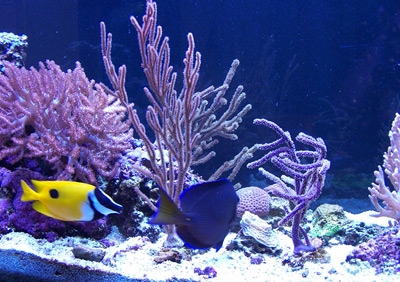Caribbean Chris, who is currently in the process of moving his family down to Florida (apparently Ohio in mid-winter isn’t sufficiently tropical for his taste!), recently tore down his 127-gallon Caribbean reef biotope aquarium and bequeathed to me a variety of different invertebrates, including several species of gorgonian, rock flower anemones, Ricordea, lettuce corals, and others, along with a lovely Atlantic blue tang. Fortunately, there was plenty of room in my 125-gallon tank to accommodate all these specimens, as it held only five fish and a few soft corals at the time.
As someone who generally makes stocking decisions at the approximate pace of molasses in January (thus the low stocking rate in my tank), I, of course, had some concerns about how this influx of livestock would affect my system and whether all of CC’s valued specimens would survive the transition and thrive under my care. Fortunately, the whole process went off as smoothly as could be hoped.
Well, almost as smoothly.
There have been a few minor issues, truth be told. The first occurred a day or two after the livestock was introduced, when my one-spot foxface decided to feast on a fluorescent-green lettuce coral, denuding about two-thirds of its skeleton. It didn’t bother any of the other newcomers and still hasn’t several weeks on. Apparently there was just something about that one coral that proved irresistible. The foxface now appears to be leaving the coral alone, so I’m hoping it will rebound given time and proper conditions. Still, how aggravating!
The other issue is a particular gorgonian that thus far refuses to polyp out no matter where I place it relative to the light and water flow. All the others opened with little to no coaxing and are looking great, so I’m left wondering, is the reluctant specimen unhappy with its placement? Happy with the current but unhappy with the lighting or vice versa? Well situated but still stressed from the move? Suffering the effects of allelopathy? Turned off by my taste in music (what could a gorgonian possibly have against Gordon Lightfoot or the Kingston Trio)? Only time will tell.
As these two “flies in the ointment” illustrate, when it comes to reefkeeping, there’s always something, isn’t there? There’s always some minor imperfection (if not a major one), some aspect that falls just short of the mark we set for ourselves. In fact, as I think back over all the systems I’ve kept, I can recall at least one issue I grappled with for each one—if not a coral that wouldn’t cooperate, then a pitched battle with bubble algae or hair algae, a piece of equipment that underperformed (but I couldn’t afford to replace), a water parameter that wouldn’t come into line, a fish that misbehaved toward its tankmates, or some other irksome event. What’s more, whenever we manage to resolve one problem, it seems another is always waiting to step up and take its place.
I’ve also noticed there seems to be a peculiar correlation between the emergence of such imperfections and the arrival of guests in my home. For example, my leather corals can remain fully extended and gorgeous-looking for 364 days running but then decide to contract, withdraw their polyps, and “sulk” on the morning of day 365 when guests are scheduled to arrive. Mind you, the guests don’t know any better and, indeed, often comment on how great the tank looks. But to me the closed up leathers (or algae outbreak or what have you) is like the dirty fork in Monty Python’s famous Restaurant Sketch—“a vast bowl of pus.”
But the simple fact is, perfection is unattainable in the reefkeeping hobby and challenges to be overcome are the rule, not the exception. As Paul B has pointed out repeatedly, it’s the problems that keep things interesting and that those who are too averse to challenges might be better advised to take up stamp collecting.
Perhaps fictional baseball manager Jimmy Dugan put it best when he (never actually) said, “[Reefkeeping] is supposed to be hard. If it wasn’t hard, everyone would do it. The hard…is what makes it great!”
That and “There’s no crying in reefkeeping.”



